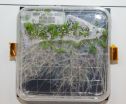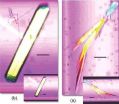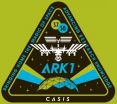HOUSTON, TX, March 27, 2014 (Press-News.org) Riding a dragon is a fantasy many have and few fulfil, but if you're interested in sending research to the International Space Station, the Center for the Advancement of Science in Space (CASIS) can help bring those dreams to life. To clarify, this "dragon" is actually a spacecraft carrying cargo and supplies to the orbiting laboratory and the "ride" is for the research proposed by investigators. This simply adds the magic of discovery to the journey, as knowledge expands with each result from microgravity experimentation aboard the space station.
Advancing Research Knowledge 1 (ARK 1) is the first increment marking a series of research payloads being sent to the space station under the CASIS umbrella. The nonprofit manages the U.S. national laboratory aboard the space station to maximize use of the in-orbit research facility. Through a formal solicitation process as well as an unsolicited proposal process, CASIS has pathways whereby new and existing users within academia, industry and other governmental agencies can access the space station for research and technology development for the benefit of life on Earth.
"The role of CASIS is to bring the possibility of conducting related research aboard humanity's greatest technical platform to reality. While the task of CASIS is challenging, the possible success stories have the potential to greatly improve how we live our lives here on Earth," said CASIS Chief Operating Officer, Duane Ratliff.
CASIS works to facilitate and promote innovative research on the station, which is made possible through a strong relationship with NASA and flight providers like Orbital Sciences Corporation and SpaceX. Since its inception in 2011, CASIS has partnered with a network of over 30 flight certified hardware and integration providers or implementation partners, providing the resources needed to transport their research to space.
In January, the first CASIS-sponsored payloads were sent to the space station via Orbital' Cygnus vehicle. The launch marked a historic moment for CASIS, a first glimpse at the actualization of the organization's mission--maximizing utilization of the U.S. national laboratory portion of the space station. These first investigations demonstrate the diverse portfolio of station research CASIS has begun to broker with focuses ranging from education to biology and even fluid physics.
SpaceX is scheduled to launch its Dragon vehicle in late-March, carrying additional CASIS-sponsored research to the space station that complete the ARK 1 studies. The investigations rounding out ARK 1 aboard the Dragon capsule include research into protein crystal growth, which may lead to drug development through protein mapping, and plant biology. The more perfectly grown crystals, made possible in the microgravity environment, assist researchers with mapping and understanding the protein structures.
For instance, there is the Crystalline Monoclonal Antibody (Merck PCG) study, which focuses on the protein crystal growth of a human monoclonal antibody currently undergoing clinical trials for treatment of an immunological disease. High-quality crystalline suspensions of the antibodies in microgravity will aid in not only structure determination but also pharmaceutical applications, such as drug delivery and purification/storage of the therapeutic substance.
Next there is the IPPASE Crystal Growth in Microgravity (CASIS PCG GCF-1) investigation, which examines the inorganic pyrophosphatase, or IPPASE, enzyme that is involved in a variety of cell functions. By mapping the crystal growth, researchers may learn more about the enzyme's nature by analyzing detailed structural features.
There are several other investigations heading to the station that are pertinent to human health. The Crystallization of Medically Relevant Proteins Using Microgravity (CASIS PCG GCF-2a) study will focus on producing improved protein crystals of two proteins with multiple functions within cells. The results could assist in the development of various medical interventions. This may include benefits from anticoagulant therapies to drug treatments for cardiovascular disease, diabetes, muscular dystrophy and Parkinson's disease.
The Exploiting On-Orbit Crystal Properties for Structural Studies of Medically and Economically Important Targets (CASIS PCG GCF-2b) investigation centers on four proteins associated with human disease. These proteins crystallize on Earth but not with sufficient quality and uniformity to determine their structures. The larger, better-organized crystals grown in the microgravity environment of the space station for these specific proteins may impact drug development for Parkinson's disease, bovine spongiform encephalopathy, ethylmalonic aciduri and cutaneous squamous cell carcinoma.
The Crystallization of Huntington Exon 1 Using Microgravity (CASIS PCG HDPCG-1) investigation will examine the protein responsible for Huntington's disease. The structure of this protein remains unknown. Procuring a high-resolution mapping of this protein may have significant scientific and medical impact in understanding the structural basis for neural toxicity and developing treatments for Huntington's disease and other related disorders, such as spinocerebellar ataxia.
The Advancing Membrane Protein Crystallization by Using Microgravity (CASIS PCG HDPCG-2) investigation will study the structure of human membrane proteins. The resulting knowledge may accelerate the commercialization of next-generation drugs to treat AIDS-related dementia, high-cholesterol and a several other diseases and disorders.
The seventh CASIS-sponsored research study heading to the space station is the Molecular Biology of Plant Development in the Space Flight Environment (Characterizing Arabidopsis Root Attractions (CARA)) investigation. This investigation looks to identify the genes involved in plant root morphology and adaptive physiology--in other words, how a root knows which direction to grow when gravity is absent.
These payloads continue to reflect the diversity within the CASIS research and development portfolio and show what's possible for space station investigations. Research aboard the orbiting laboratory ranges from science, technology, engineering and mathematics education and human research to life, physical and Earth sciences to technology demonstrations. Maintaining a robust and diverse flow of investigations is a critical component to ensuring the space station national laboratory remains accessible to all types of inquiry. As a non-profit, CASIS's goal is to expand beyond a small set of researchers to include all potential investigators whose research has the potential for Earth benefit.
With the conclusion of ARK 1, attention turns to the next research suite of ARK 2. No earlier than May 6, Orbital will launch its second resupply mission to the space station, carrying with it a variety of investigations from the ARK 2 suite. ARK 2 will begin a new chapter in research, creating the capability of enhancing life on Earth: from education payloads to new hardware designed to take advantage of the outside of the station for materials research. Even rodent research investigations are planned for future payloads, to coincide with commercial investigation and drug development.
CASIS's role in ensuring the full use of this national laboratory is far from a fantasy, but has the potential to fulfil the dreams of those with microgravity research aspirations. Taking these dreams to reality--and to space--may in turn change the lives of many of us here on Earth through the advances developed from research results.
By Patrick O'Neill
CASIS Marketing and Communications Manager
CASIS-Sponsored Research Heads to Space Station Aboard SpaceX-3
The final investigations of the Advancing Research Knowledge 1 series of research payloads will launch to the space station with the SpaceX-3 mission, joining the initial portion of the suite that launched aboard Orbital 1.
2014-03-27
ELSE PRESS RELEASES FROM THIS DATE:
Rabbit TV to Reveal Breakout Content Monetization Programs at NAB
2014-03-27
Just days following the unveiling of the new Rabbit TV Content Partnership Program, the company announced its participation in NAB 2014 and its compelling plans for content monetization.
Rabbit TV's recent entry into the online media marketplace is supported by millions of viewers and its massive electronic programming guide featuring 100,000+ freely available selections coupled with pay-per-view and premium channels.
The company's new model, proven successful by the popular Rabbit TV service and based on subscriber behavioral data, identifies three unique content ...
Air pollution from traffic increases odds of hospital readmission for asthma
2014-03-27
Higher exposure to traffic-related air pollution (TRAP) dramatically increases the odds of readmission to the hospital for asthma – but only for white children, according to a new Cincinnati Children's Hospital Medical Center study.
The study shows that white children exposed to high levels of TRAP are three times more likely to be readmitted for asthma than white children with low TRAP exposure. Levels of TRAP exposure were not associated with increased risk of readmission of black children, despite their having overall higher rates of asthma readmission than white ...
Faster genetic testing method will likely transform care for patients with breast cancer
2014-03-27
Faster and cheaper DNA sequencing techniques will likely improve care for patients with breast cancer but also create challenges for clinicians as they counsel patients on their treatment options. Those are among the conclusions of a study published recently in the BJS (British Journal of Surgery). The findings provide insights into how genetic advances will soon be affecting patient care.
When a woman is diagnosed with breast cancer, it's important to know as much about her tumour as possible to determine the best treatment. Most cases of breast cancer are sporadic, ...
Dying cells in fruit fly alert neighboring cells to protect themselves
2014-03-27
Cells usually self-destruct when irreparable glitches occur in their DNA. Programmed cell death, or apoptosis, helps insure that cells with damaged DNA do not grow and replicate to produce more mutated cells. Apoptosis thereby helps protect and insure the survival of the organism.
At the GSA Drosophila Research Conference, TinTin Su, Ph.D., will report that a dying Drosophila melanogaster larvae cell alerts neighboring cells that they are in danger of suffering a similar fate.
Dr. Su and her collaborators at University of Colorado, Boulder used ionizing radiation ...
Sex chromosomes have reverted to autosomes multiple times in flies
2014-03-27
In previous research (Nature, July 2013), UC Berkeley scientists Beatriz Vicoso, Ph.D., and Doris Bachtrog, Ph.D., determined that genes on the so-called "dot chromosome," or fourth chromosome, of the fruit fly Drosophilia melanogaster are X-linked in three other related fly species.
These and other findings revealed that the fruit fly's "dot chromosome" had descended from a differentiated X chromosome and suggests that several of the chromosome's puzzling features are remnants of its heritage as a sex chromosome. For example, the expression levels of genes on the ...
Sunday driver gene headed the wrong way in inherited muscle diseases
2014-03-27
Skeletal muscle cells with unevenly spaced nuclei, or nuclei in the wrong location, are telltale signs of such inherited muscle diseases as Emery-Dreifuss muscular dystrophy, which occurs in one out of every 100,000 births, and centronuclear myopathy, which affects one out of every 50,000 infants.
What goes wrong during myogenesis, the formation and maintenance of muscle tissue, to produce these inherited muscle diseases?
Research using the fruit fly Drosophila melanogaster has implicated the gene known as Sunday Driver (Syd) as a novel regulator of myogenesis. The ...
Caffeinated fruit flies help identify potential genes affecting insecticide resistance
2014-03-27
As Rachel Carson predicted 50 years ago in her groundbreaking book Silent Spring, crop pests are capable of outwitting the chemical compounds known as xenobiotics that are devised to kill them. This development of resistance to insecticides is a serious problem because it threatens crop production and thereby can influence the availability and costs of many foods as well as the economy.
To understand the genetic mechanisms underlying insecticide resistance, University of Kansas scientists turned to the fruit fly Drosophila melanogaster and caffeine, a stimulant drug ...
Gene mutations in flies and humans produce similar epilepsy syndromes
2014-03-27
Four years ago, University of Iowa scientists discovered that mutations in the prickle gene in Drosophila were responsible for much more than merely altering the bristles on the fly's body to point them in the wrong direction.
Prompted by a colleague's finding that PRICKLE gene mutations were responsible for triggering a form of epilepsy in humans, John Manak, Ph.D., who led the fly research team, took a closer look at the Drosophila prickle mutants. (PRICKLE refers to the human gene, while prickle is the Drosophila form of the gene.)
Through a series of experiments, ...
Resistance and tolerance mechanisms play role in cancer as well as infections
2014-03-27
A Stanford University lab whose studies have advanced scientific understanding of resistance and tolerance defense mechanisms to bacterial and viral pathogens has now turned its sights on cancer.
"Just as there are resistance and tolerance mechanisms that target invading microbes, we predicted that there are also resistance and tolerance mechanisms that control a host's response to cancer," David Schneider, Ph.D., who heads the lab, and postdoctoral researcher Adler R. Dillman, Ph.D., wrote in their GSA Drosophila Research Conference abstract.
While resistance refers ...
Female fly genomes also populated with de novo genes derived from ancestral sequences
2014-03-27
Earlier this year, researchers in David J. Begun, Ph.D.'s lab at UC Davis reported that they had uncovered 142 de novo genes that originated in the ancestral non-coding DNA sequences and are segregating in Drosophila melanogaster populations.
Dr. Begun and postdoctoral scientist Li Zhao, Ph.D., identified de novo genes by comparing the RNA transcripts of the testes of several wild-derived strains of D. melanogaster to the standard reference genome for this fly species and to the RNA transcripts and genomes of two other Drosophila species.
Their results suggested that ...
LAST 30 PRESS RELEASES:
Tracing the quick synthesis of an industrially important catalyst
New software sheds light on cancer’s hidden genetic networks
UT Health San Antonio awarded $3 million in CPRIT grants to bolster cancer research and prevention efforts in South Texas
Third symposium spotlights global challenge of new contaminants in China’s fight against pollution
From straw to soil harmony: International team reveals how biochar supercharges carbon-smart farming
Myeloma: How AI is redrawing the map of cancer care
Manhattan E. Charurat, Ph.D., MHS invested as the Homer and Martha Gudelsky Distinguished Professor in Medicine at the University of Maryland School of Medicine
Insilico Medicine’s Pharma.AI Q4 Winter Launch Recap: Revolutionizing drug discovery with cutting-edge AI innovations, accelerating the path to pharmaceutical superintelligence
Nanoplastics have diet-dependent impacts on digestive system health
Brain neuron death occurs throughout life and increases with age, a natural human protein drug may halt neuron death in Alzheimer’s disease
SPIE and CLP announce the recipients of the 2025 Advanced Photonics Young Innovator Award
Lessons from the Caldor Fire’s Christmas Valley ‘Miracle’
Ant societies rose by trading individual protection for collective power
Research reveals how ancient viral DNA shapes early embryonic development
A molecular gatekeeper that controls protein synthesis
New ‘cloaking device’ concept to shield sensitive tech from magnetic fields
Researchers show impact of mountain building and climate change on alpine biodiversity
Study models the transition from Neanderthals to modern humans in Europe
University of Phoenix College of Doctoral Studies releases white paper on AI-driven skilling to reduce burnout and restore worker autonomy
AIs fail at the game of visual “telephone”
The levers for a sustainable food system
Potential changes in US homelessness by ending federal support for housing first programs
Vulnerability of large language models to prompt injection when providing medical advice
Researchers develop new system for high-energy-density, long-life, multi-electron transfer bromine-based flow batteries
Ending federal support for housing first programs could increase U.S. homelessness by 5% in one year, new JAMA study finds
New research uncovers molecular ‘safety switch’ shielding cancers from immune attack
Bacteria resisting viral infection can still sink carbon to ocean floor
Younger biological age may increase depression risk in older women during COVID-19
Bharat Innovates 2026 National Basecamp Showcases India’s Most Promising Deep-Tech Ventures
Here’s what determines whether your income level rises or falls
[Press-News.org] CASIS-Sponsored Research Heads to Space Station Aboard SpaceX-3The final investigations of the Advancing Research Knowledge 1 series of research payloads will launch to the space station with the SpaceX-3 mission, joining the initial portion of the suite that launched aboard Orbital 1.



